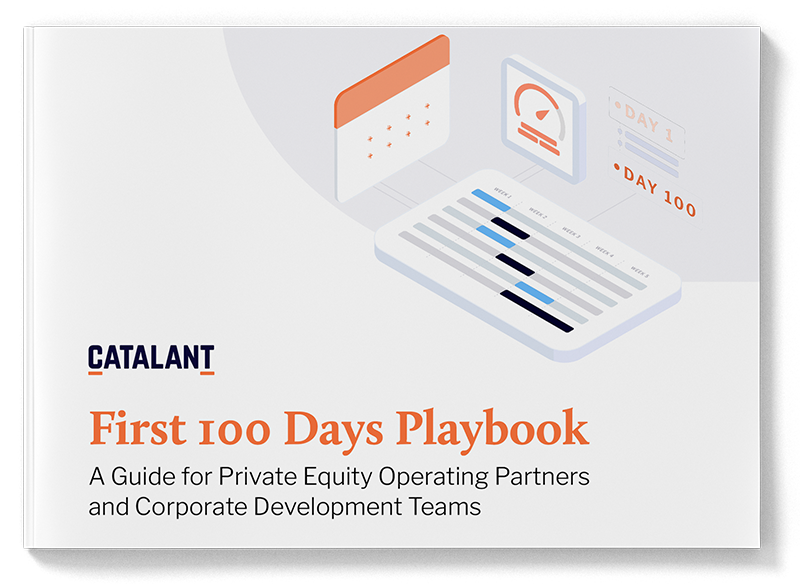Unlocking M&A Success: The Role of Talent and Culture

This article is part of the latest issue of the Catalant Quarterly: “The ‘First 100 Days’ Strategy: A Blueprint for Accelerated Value Creation.” Read the issue here and download the First 100 Days Playbook.
Businesses spend over $2 trillion annually on M&A transactions, yet a consistent failure rate of 70-90% underscores the critical and often overlooked importance of properly integrating talent and organizational culture.
In the tumult of acquisitions, talent and organizational culture are frequently relegated to a secondary role, overshadowed by financial considerations. However, their pivotal role in driving success demands they be accorded greater attention from the outset.
Mergers and acquisitions invariably sow seeds of uncertainty, particularly among employees grappling with apprehensions about their future within the evolving organizational landscape. Despite the wealth of literature advocating for meticulous post-M&A structuring and staffing, the following strategies are imperative to ensure sustained success and avert the resurgence of disparate subcultures:
- Cultivate Intentional Organizational Culture: Defining the desired organizational culture and operational ethos serves as the bedrock for the merged entity. Identifying requisite talents aligned with these principles is paramount for thriving in the new environment.
- Craft the Organizational Framework and Roles to Serve Business Objectives: Designing the pivotal roles and organizational architecture should prioritize alignment with strategic imperatives over preserving existing personnel structures
- Conduct Equitable Talent Assessment and Retain Key Talent: A fair and comprehensive evaluation of talent from both merging entities is essential, assessing not only past performance but also potential within the reconfigured organization. Implementing strategies to retain key employees is critical to delivering on organizational goals
- Engage employees through effective communication: Transparency and communication are critical for gaining and maintaining the trust of the workforce, ensuring talent retention, and fostering engagement within the organization.
Cultivating Intentional Organizational Culture
Organizational culture constitutes the deep fabric of “how” an organization operates and is perceived by its workforce. For example, P&G describes its statement of culture and values as “a moral compass for guiding decisions.”
Even in instances where an acquired organization is sought out for their culture, as the saying goes, “what got you here may not get you there.” The resulting new organization must have its own unique culture. Russell Reynolds Associates writes, “The disruption caused by the transition to a NewCo also offers a unique opportunity to engage the organization in building a positive culture. The reason? More often than not, employees are actively looking for new direction and support.”
The inevitable change environment that M&A transactions offer creates an opportunity to redefine and mold this culture to drive value creation. Deloitte stated that companies who proactively manage their culture demonstrate revenue growth over a 10-year period that is, on average, 516% higher than those who do not. By discerningly evaluating the merging entities’ cultures and fostering collaboration in defining values and communication norms, organizations can lay the groundwork for a cohesive and purpose-driven environment.
Key steps to achieve this are:
- Review the cultural artifacts that both organizations have, such as mission statements, values, written norms, employee surveys, etc
- Define the culture required for success with leaders and what will align with the mission of the new organization. This includes codifying the key operating values, behaviors and norms essential to the new organization
- Involve employees from various levels and across both organizations in the definition of the new culture. This approach fosters collaboration and encourages adoption, rather than imposing directives from above, which are less likely to be embraced and widely adopted.
Crafting the Organizational Framework and Roles to Serve Business Objectives
The goal of an organization is to deliver the mission or strategy and align with culture and values. Hence, a clear thesis is paramount for effectively structuring the new organization. Instead of attempting to fit the acquired company into an existing structure, an organizational framework that focuses on delivering business priorities and facilitating strategic execution is essential.
While executives often start with the existing workforce and restructure later, it is preferable to prioritize both the short-term and long-term needs of the new business.
- Begin by defining the essential roles necessary to achieve desired outcomes and identify the requisite skills, both functional and behavioral, for each role. Leadership plays a pivotal role in ensuring alignment with the success criteria for these roles, which should be harmonized with the key values and behaviors identified during the establishment of the new culture, thus fostering cohesion throughout the process.
- Once the key roles have been identified, deliberate on how to structure these roles within the organization. Various organizational structures, such as functional, matrixed, and cross-functional teams-based structures, exist. It is imperative to select the most suitable structure for the new company based on decision-making processes, workflow, and desired outcomes.
- An interim organizational structure may be necessary before arriving at the final structure, as the requirements in the initial years may differ from those once the organizations are fully merged.
Conducting an Equitable Talent Assessment and Retaining Key Talent
It is important to evaluate all talent across both organizations. This evaluation should be equitable, based on past performance and on cultural attributes that will encourage success in the new organization, in alignment with the success criteria for the role e.g., learning agility, adaptability and flexibility, ability to thrive in uncertain situations, resilience. This process will give clarity to the current workforce’s strengths and gaps that may have to be filled externally.
- Choosing individuals for positions is the subsequent pivotal phase. It’s essential to take both a top-down and a bottom-up approach to this process since direct line managers possess clearer insights into their employees’ potential, interests, and performance. One approach is to enable employees to apply for specific roles, empowering them to play an active part in their success within the new organization.
- After positions within the organization have been filled, it’s crucial to implement retention strategies to retain your top performers and keep them engaged. The last thing a fledgling organization needs when striving to quickly generate value is to have key employees with indispensable knowledge depart for rival organizations.
- One consideration to make in the short term is how to use the ever-growing contingent workforce to supplement talent and capability gaps as integration begins.
Engaging employees through effective communication
An AON study of M&A identified the four key drivers of engagement during M&A and other changes that impact people’s jobs to be:
- Involvement in decision making
- A clear understanding of their career path
- Corporate encouragement for professional development
- The ability to participate in a two-way dialogue with management
Transparent and regular communication is a critical first step. By articulating the rationale behind changes and recalibrating success criteria, organizations can foster a culture of resilience and adaptability, making it poised for sustained success in the years ahead.
- Ensure employees are given ample opportunities to inquire and participate throughout the process.
- Value their input in shaping the organizational culture, establishing success metrics, and even in selecting crucial positions.
- Guarantee communication channels between management and staff remain accessible, allowing them to voice concerns and receive clarifications promptly.
Every organization possesses its own distinctive traits, and no two deals are identical. By incorporating these principles early, any organization can purposefully shape its structure and ensure the placement of the appropriate talent to foster long-term success.

Download the First 100 Days Playbook
Learn more about why the first 100 days after a transaction so important.
Meet the Author

Sapna Harichand is an independent consultant in Glen Rock, NJ. She is focused on helping organizations deliver major transformational initiatives that deliver exceptional employee experiences and drive strong organizational culture. She serves as a leader and advisor to organizations in the areas of HR, Sustainability and Operations. She is a purpose driven executive with over 20 years of experience in both Big 4 consulting as well as internally within F100 companies. Sapna holds an M.A. in Industrial and Organizational Psychology from NYU.
Related Articles
Share Article












